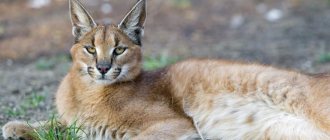Tiger
In first place among large cats is the tiger, one of the representatives of the panther genus.
Most tigers live in Asia and feed on ungulates. These predators prefer to hunt alone, in the morning or late afternoon, and they see in the dark six times better than a person. Some characteristics of a tiger:
- weight varies from 180 to 300 kg;
- life expectancy up to 15 years, in captivity 25 years;
- the largest of the subspecies, the Amur tiger, reaches a length of three and a half meters;
- the predator accelerates to 60 km/h.
The most common subspecies of tiger, the Bengal, consists of 3,000–4,500 individuals. Three of the nine species have already become extinct, the rest are endangered.
a lion
A noble, proud and majestic predator living in the African savannas. Lions live in families or prides. Only females hunt, often in groups. Of the entire cat family, lions are the tallest.
a lion
Some facts about lions:
- weight reaches 250 kg;
- life expectancy 10-14 years, in captivity can reach up to 20 years;
- The size of the lion in length is from 2.7 to 3 meters. One of the largest lions was 3.3 meters long;
- The usual running speed of these animals is 50 km/h, the maximum is 80 km/h.
The lion species is at risk of becoming extinct; their population in Africa has declined by 40% in recent decades.
Other big cat species
British
British, whose homeland is England. This is a soft, plush bun cat that is incredibly cozy, but often has an independent personality. At the beginning of their acquaintance, she demonstrates royal restraint and composure, but soon becomes kind and affectionate. The more time she spends with her owner, the stronger her trust and affection. The weight of an adult British cat is from 4 to 8 kg.
British cat
From the name it is clear that its homeland is Norway. The breed is very popular in the countries of Northern Europe and has external similarities with Siberians, Turkish Vans and Maine Coons.
Norwegian forest cats are classified as long-haired breeds. They have a strong build and impressive size. These animals are distinguished by their kind character and good manners. “Norwegians” are not characterized by bad behavior. They are tolerant even of dogs and capricious children, and are reserved towards strangers. It is noteworthy that cats of the Norwegian breed become attached to a person, and not to a house, as is commonly thought.
Norwegian cats have a kind character and good manners.
The weight of a Norwegian cat, like most breeds, changes noticeably as the animal grows older. Representatives of this species grow slowly, reaching full maturity only by five years. At this age, the female weighs about 5.5 kg, and the male weighs from 6 to 9 kg.
The Carthusian cat (chartreuse) is a French breed of unusually beautiful and equally jealous purrs with thick gray-blue fur and orange (bright yellow) eyes. There are different versions of the origin and history of the breed. According to one of them, Chartreux in the Middle Ages were considered cats of commoners.
However, peasants and artisans valued them not for their beautiful eyes and character, but for their fluffy skin and tender meat. Fortunately, the dark times have passed, and today Carthusian beauties are purchased as pets. These cats are capable of becoming attached to people, but cannot tolerate the presence of other animals in the house.
We suggest you familiarize yourself with Gypsy moth fight against gypsy moth
The weight of a cat is 6-7 kg, and lighter cats weigh from 4 to 5 kg. Carthusians increase in size and reach maturity by 5 years, but fluffy Chartreuse ladies do not grow after 3 years.
Chartreux are calm and silent, have a thin voice
Top dangerous breeds
In addition to peaceful and friendly cat breeds, there are also those that are endowed with a willful and cocky disposition. Such pets are poorly adapted to living together with people and, under certain circumstances, become very aggressive and unsafe. When enraged, these cats can cause no less harm than a poisonous spider or an angry dog.
The list of the 10 most dangerous breeds includes:
- savannah;
- manul;
- Abyssinians;
- Siamese;
- Maine Coon;
- British;
- Siberian;
- Bengali;
- chausie;
- reed
Savannah
These large graceful animals are considered one of the most dangerous cats in the world. Although Savannahs can be tamed, there is always a risk that they will become aggressive.
The owners of these cats must always be on alert, because their graceful pets often perceive strangers as objects of hunting.
Manul
This wild feline is similar to a lynx and is completely untamed. Even a manul raised in captivity will avoid people. These aggressive and dangerous cats are not suitable for home keeping.
No matter how hard you try, it is impossible to teach wild Pallas’ cats commands and stop them from damaging their owner’s property.
Abyssinians
These sophisticated oriental beauties also belong to the category of dangerous cats. It turns out that representatives of the breed are very vindictive and immediately take revenge for insults inflicted on them. Without proper attention, Abyssinians become wild and aggressive.
Siamese
These cunning and dangerous cats are very aggressive and vindictive. They can harbor a grudge for a long time and take revenge at the most unexpected moment. Siamese cats do not like excessive attention and do not tolerate familiarity. It is not advisable to take representatives of the breed into families with children.
These cats pose a real danger to children who do not yet know how to properly handle a pet.
Maine Coon
These smart and flexible animals are endowed with a changeable disposition and can begin to take revenge even for a minor offense. Large and dangerous Maine Coon cats cannot stand loneliness and, due to their size, are capable of crippling a person.
British
This cute domestic cat is endowed with an independent and willful character. The proud and freedom-loving Briton has no love for strangers and prefers to distance himself from them. He can hardly tolerate being picked up or forced to play.
Siberian
This large and quite dangerous cat is wary of strangers and can only get along with someone who has a highly developed sense of self-esteem.
An independent and strong Siberian can be both affectionate and sensitive, and aggressive. To smooth out developed hunting instincts and avoid unwanted behavior, this cat must be trained from an early age.
Bengal
This impulsive and dangerous cat has highly developed hunting instincts. To prevent a Bengal kitten from becoming an aggressive monster, it is raised in a calm atmosphere.
An active and mobile animal does not like to be forcibly held in arms and does not tolerate being addressed in a raised voice. An angry Bengal cat can be unsafe and capable of causing serious damage.
Chausie
These powerful animals, more like a puma, also belong to the category of aggressive and unsafe breeds. Aggressive cats need to be dealt with constantly and dangerous games should not be played.
Chausies have developed hunting instincts, do not tolerate confined spaces and are not suitable for apartment living.
Reed
This aggressive and dangerous cat with the appearance of a lynx is practically impossible to domesticate and is difficult to train. She needs constant communication, and if there is a lack of it, she quickly runs wild.
This is interesting: Why is the cat thin and not getting fat?
Liger
The tiger is considered to be the largest predator of the cat family, but there is an animal that defeats it. The liger is a hybrid of a lion and a tigress that is bred in captivity.
Liger Hercules
Interesting features of this unusual species:
- the liger Hercules was listed in the Guinness Book of Records as the largest cat on Earth;
- has a weight of 400 kg and a height of 3.7 meters;
- there are 25 individuals of this species in the world;
- ligresses are capable of childbearing, which is not typical for hybrids;
- ligers love to swim.
Causes of aggressiveness in cats
Cat rage can be triggered by several factors, the most common of which are:
- illness and poor health;
- fear of people;
- hunting instincts;
- self-defense;
- genetic predisposition.
Any cat is, first of all, a predator with its own needs and instincts, which can manifest themselves at any moment. This should always be remembered, especially if you decide to get a pet from the list of potentially dangerous and aggressive breeds.
Liked? Please rate the article!
You might be interested
The most terrible dog
What breed of cats to choose for an apartment
Rating of the most aggressive dogs
Do Sphynxes need mustaches?
Diseases that affect large domestic cats
The health of domestic cats, including large cats, depends on genetics, as well as how they are cared for and what they are fed. If the set of hereditary diseases depends on the breed, then the consequences of improper nutrition and maintenance are the same for all cats. They lead to pathologies such as:
- urolithiasis, although it is believed that all cats are predisposed to it. A healthy diet allows you to minimize the manifestations of the disease and the frequency of its exacerbations;
- food allergies, the cause of which in most cases is again considered to be improper feeding of the pet;
- skin problems: they can be the result of an unbalanced diet, poor care of the animal, as well as the presence of parasites in the fur;
- dysfunction of the digestive organs. In rare cases, they are caused by congenital diseases; more often they are caused by the consumption of stale, low-quality food, as well as foods prohibited for animals (for example, sweets, spicy and salty foods). In addition, the health of the digestive tract and the body as a whole is undermined by intestinal worms and protozoa. They reduce immunity and poison the internal organs of the animal with their waste products.
Each variety of domestic cat has a predisposition to certain diseases.
Table. Breed diseases of big cats
| Breed name | Photo | Possible health problems |
| Asherah | The breed has no genetically determined pathologies, which is explained by the good health of its ancestor, the Serval. Possible inflammation of the urinary system | |
| Maine Coon | Joint diseases (arthritis, arthrosis, osteoarthritis, hip dysplasia), skin pathologies (abscesses, phlegmon, ostiofolliculitis, eczema), disorders of the urinary system (nephritis, nephrosis, pyelitis, urethritis, cystitis) | |
| Ragdoll | Hip dysplasia, feline hypertrophic cardiomyopathy | |
| Chausie | Digestive disorders, obesity | |
| Siberian | Food allergies, inflammatory eye pathologies (conjunctivitis and others), obesity |
Leopard
A leopard is a large cat, smaller than a tiger or lion. Lives in Africa, Asia, the Far East in Russia. Has spots all over the body. There are also black panthers that also have spots, but due to melanism they do not show through.
We suggest you familiarize yourself with Alopecia in cats: causes and treatment || Belly hair loss in cats
Leopard
Leopard Characteristics:
- weight in males is up to 80 kg, in females up to 65;
- body length, excluding the tail, 0.9-1.9 meters;
- life expectancy 12-15 years, in captivity – up to 23 years;
- Leopards climb trees and can swim and fish.
The population of these animals is steadily declining: five species are already listed in the Red Book, and the number of Far Eastern, or Amur, leopards is 60 individuals. This is due to the constant cutting down of trees in the main habitats, poaching and a decrease in the food supply.
The most powerful wild cats
So, we learned about which representatives of the cat family are rightfully considered the largest and strongest in the world. Now it's the turn of the wild cats.
Top 10 most powerful wild cats:
- Ocelot
Ocelot is the strongest cat in the world (if we take into account only representatives of wild cats). Its body weight reaches 17 kilograms, and its length is one and a half meters.
- Chinese cat
A wild cat that lives exclusively in the vastness of China takes second place in the top 10. The animal reaches 1.4 meters in length, and its body weight averages 8-10 kilograms .
- Serval
The so-called “bush cat” weighs approximately 17 kilograms and is about 1.4 meters long. In addition, servals are flexible and capable of jumping high.
- speckled cat
This cute cat, known for its ability to catch fish, weighs about 14 kilograms and reaches a length of just over one meter. A very strong cat.
- golden cat
The African cat, which is called golden because of its color, is about a meter long and weighs about 13 kilograms.
- Amur forest cat
In sixth place in the top is the Amur forest cat, a beautiful representative of the family, her weight is only 7 kilograms , and her body length is one meter.
- Swamp Lynx
A beautiful cat that lives in damp places, near swamps and reed thickets, weighs about 10 kilograms. Its body is 80-90 cm long.
- Margay
The margay or long-tailed cat is very similar to our pets. Its weight does not exceed seven kilograms, its body length is about 70 cm.
- Pampas cat
The grass cat, otherwise known as the Pampas cat, weighs about six kilograms and reaches 40 centimeters in length . It is quite strong, although it avoids large predators.
- Manul
The top 10 is completed by the Pallas' cat, whose color is somewhat reminiscent of a leopard. Its body length is about a meter, weight - up to six kg. Its bite is quite strong, despite the small weight of the animal.
How to care for a domestic cat?
In order for a pet to demonstrate the best breed qualities, become the pride of the family and the envy of others, it is necessary to properly care for it. The general principles of feeding and keeping domestic cats, regardless of their type, are the same. Slight differences may be due to breed characteristics, such as coat length and quality.
In order for a cat to live happily in a family, it is important to remember the following:
- Choosing a kitten is a responsible undertaking. It is worth buying a pet only from trusted breeders who are ready to document the breed and health of the animal;
- cats need vaccination, especially if they go outside. The types and schedule of vaccinations can be clarified at your local veterinary clinic;
- There are no trifles in pet nutrition. All the owner’s mistakes are reflected in the condition and appearance of the cat. The ideal nutrition system is the use of premium dry food, which can be purchased taking into account the characteristics of the breed. Contrary to popular belief, these compounds are not dangerous from the point of view of the formation of urates (kidney stones). It is important to ensure that your cat always has enough fresh water. Adherents of natural nutrition should know that an unbalanced diet worsens the condition, well-being and appearance of the pet. Vitamin and mineral deficiency will have to be replenished with special supplements;
- Caring for a cat involves maintaining its neat appearance and normal health. Among other things, this includes brushing, infrequent bathing, trimming nails, cleaning ears and monitoring the condition of eyes and teeth;
- the animal must have its own place in the house (apartment), where you can quietly retire without fear of interference in your personal cat space;
- a small predator requires understanding and respect. This is more true when there are children in the house. Adults should explain to the child that an animal is not a toy, but a family member.
How to care for a cat's fur?
The largest domestic cats are popular and cost a lot of money. Such specimens are a real decoration for the family and home. However, the yard musk also has a chance of becoming a treasure. With good care, a purebred cat can easily grow into an intelligent and chic animal, which will be no worse than the top 5 people.
Jaguar
The jaguar belongs to the genus panther. It lives in South and Central America, feeding on both small rodents and adult mammals. He can swim and climb trees. It spends its life alone, meeting other representatives of its species only during reproduction.
We suggest you familiarize yourself with How to name a black cat Suitable names for night-colored fluffies
Some features of this predator:
- body weight – 60-90 kg;
- body length, not counting the tail, 1.1-1.8 meters;
- life expectancy is 10 years, in captivity – up to 25 years;
- the jaguar hunts at night and prefers to sleep during the day;
- the animal is listed in the Red Book.
The genus of panthers is distinguished by the fact that the spots on the skin of predators are unique, like human fingerprints.
How strong is a tiger
To understand how strong and formidable a tiger is, just look at its sharp fangs. Tigers are well versed in hunting methods. Their signature move is plunging their fangs into the enemy’s neck. They use their powerful paws no less practically. Even such an opponent as a bear can die from one blow from a tiger's paw, especially if it was struck on the head. In this case, the skull is instantly destroyed and the animal dies.
Hunting is a common thing for tigers
Snow Leopard
The snow leopard, or snow leopard, belonging to the genus Uncia, lives in the mountains of Central Asia. They live alone in mountain caves, travel a lot, do not show aggression towards people, attacks are rare.
Features of snow leopards:
- body length with tail is 2-2.3 meters;
- body weight – up to 60 kg;
- life expectancy 20-25 years;
- leopards jump up to 6 meters in length and up to 3 meters in height;
- Snow leopards cannot meow, purr, or growl.
The snow leopard is listed in the Red Book, since there are only 6,000 snow leopards left.
Puma
The puma is a small cat, although its size is not small at all, 1-1.8 meters in length. It lives in North and South America, hunts deer, and leads a solitary lifestyle.
Interesting Facts:
- in nature, pumas live up to 20 years;
- the main enemies of pumas are bears, jaguars and wolves;
- the cubs do not come out of hiding unless their mother calls them;
- the puma reaches 65 km/h on the plains, but quickly gets tired.
Pumas are constantly hunted, but due to their adaptability to different living conditions, their subspecies are not under threat of complete extermination.
Fifth place – Puma
Puma
Other names for pumas are mountain lion, cougar, and panther. The puma belongs to the genus Puma. Lives in North and South America. Lives in bushes, swamps and forests. Mountain lions are solitary and territorial animals, with ranges ranging from 250 sq. km up to 950 sq. km. The puma has yellow-brown fur, straight ears, and a long tail. The animal is born with spots that disappear as they grow.
Males weigh on average from 50 to 100 kg, females - 30-65 kg . Pumas have large, strong paws and proportionately the largest hind paws in the cat family. This physique helps to jump long distances (4-12 meters) and run fast (60-80 km/h).
The puma does not roar, it makes sounds of hissing, growling, whistling, screaming. Mountain lions are active at dusk, at night, and at dawn; These are predators that eat prey of various sizes - from insects, rodents to medium and large ungulates (especially deer).
Interesting: The most dangerous snakes - list, names, descriptions, where they live, photos and videos
The total mountain lion population is estimated to be less than 50,000. The average lifespan in the wild is 8-13 years, in a zoo it is about 20 years.











